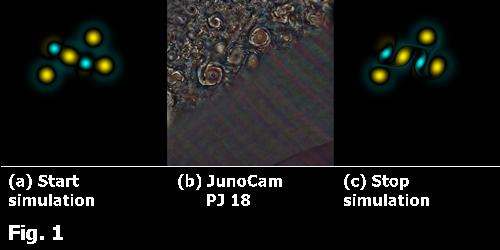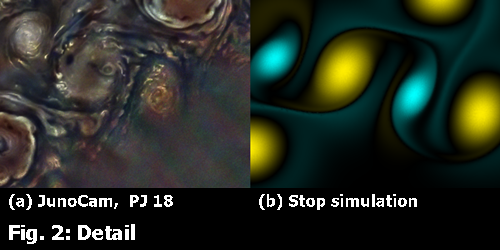Comparing Selected JunoCam Images of Jupiter with Vorticity Fields Occuring In Simulations of Two-Dimensional Euler Fluids
- 1Independent scholar, Stuttgart, Germany (ge@junocam.pictures)
- 2Planetary Science Institute, Tucson, Arizona, USA
- 3Jet Propulsion Laboratory, California Institute of Technology, Pasadena, California, USA
Abstract
Comparing JunoCam images with simulation runs of two-dimensional Euler fluids reveals similarities between the morphology of Jupiter's cloud tops and simulated vorticity maps. We present examples of these analogies. They are required to establish conjectures that state these similarities in a more formal way.
Introduction and Context
JunoCam [1] has been collecting images of Jupiter's cloud tops for almost four years at the time of the submission of this abstract. In examining these images, we realized that two-dimensional simulations of Euler fluids [2] revealed patterns in vorticity fields reminiscent of structures in Jupiter's cloud tops. We pursue this initial observation further. A small collection of analogies between real data and simulations is presented, which inspire formal conjectures describing a correlation between vorticity and cloud features. These initial conjectures result in algorithm candidates that translate cloud morphology into vorticity and can be assessed and further refined on the basis of fluid-dynamical simulations.
In a larger-scale context, when two or more JunoCam images cover the same area of Jupiter with a time delay of several minutes, methods similar to stereo correspondence can be applied to retrieve velocity or vorticity field data. Displacements of corresponding areas of the surface between images can be used either to estimate a velocity field directly, or via the stream function component of a Helmholtz decomposition indirectly. Alternatively, measured rotations of surface areas can be used to estimate vorticities. Vorticity data inferred by any of these methods provide a low-resolution context and a reference for a refinement of the vorticity field on the basis of spatially higher-resolved morphological considerations.
The presentation will focus on a small survey of JunoCam images together with simulation runs developing structures similar to those observed in the images. This collection of examples is required for the empirical definition of formal conjectures connecting morphology with vorticity.
Example
Figure 1 shows an excerpt of a map of Jupiter's north polar region during the PJ18 flyby that suggests a simplified model to initialize a simulation run. The initial model is simplified to consist of six Gauss vortices, representing four circumpolar cyclones (CPCs in yellow) and two anticyclonic white ovals (AWOs in blue). After a short simulation run, the vortices develop filamentary vorticity structures that are also apparent in the original JunoCam image, see detail in Fig. 2.


Conjectures
-
The above example suggests that the brightness of the cloud tops is correlated with the total amount of the relative vorticity.
-
Intact vortices of similar size that touch each other are of opposite sign. They form a filamentary structure between them consisting of two parallel filaments of opposite vorticity.
-
Two nearby cyclones are separated by a filament of anticyclonic vorticity.
References
[1] C.J. Hansen, M.A. Caplinger, A. Ingersoll, M.A. Ravine, E. Jensen, S. Bolton, G. Orton. Junocam: Juno’s Outreach Camera. Space Sci Rev 2013:475-506, 2017
[2] G. Eichstädt, C. Hansen, G. Orton. Fluid Dynamical 2D Simulations of Jupiter's South Polar Region Based On JunoCam Image Data. EGU2020-12025,
How to cite: Eichstaedt, G., Hansen-Koharcheck, C., and Orton, G.: Comparing Selected JunoCam Images of Jupiter with Vorticity Fields Occuring In Simulations of Two-Dimensional Euler Fluids, Europlanet Science Congress 2020, online, 21 Sep–9 Oct 2020, EPSC2020-1007, https://doi.org/10.5194/epsc2020-1007, 2020.

